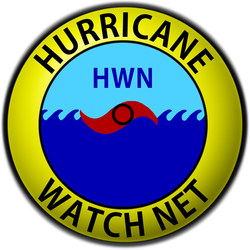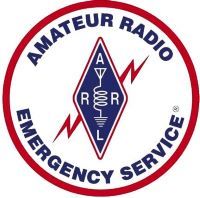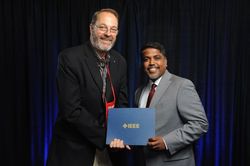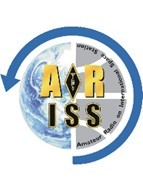 October 6, 2022 John E. Ross, KD8IDJ, Editor
| ||||||
Amateur Radio Active During 2 Weeks Of Hurricanes The VoIP Hurricane Net, the Hurricane Watch Net (HWN), and the Amateur Radio station at the National Hurricane Center, WX4NHC, contributed hundreds of hours tracking and taking reports for hurricanes Fiona and Ian. Amateur radio operators from Puerto Rico, Florida, and the US east coast worked for almost 2 weeks, making sure damage reports and requests for assistance were dispatched in a timely manner. HWN Manager Bobby Graves, KB5HAV, reported that their activation for Hurricane Fiona lasted 39.5 hours. There were 109.5 hours on-air manpower and 246.5 total man-hours. "The HWN was activated four times for Fiona: twice on its approach to Puerto Rico, and twice on its landfall," said Graves. "We collected and forwarded 23 surface reports to the National Hurricane Center in Miami by way of WX4NHC." For Hurricane Ian, HWN Assistant Manager Stan Broadway, N8BHL, added, "Our activation for Ian lasted for nearly 5 full days, with a total of 83 hours. There [were] a total of 383.5 hours of on-air manpower and 1,014.5 total man-hours. We collected and forwarded 164 surface reports to the National Hurricane Center." The VoIP Hurricane Net reported that, over the entire course of Ian, from its tropical storm force effects in Grand Cayman, major landfall in Cuba and southwest Florida, and landfall in South Carolina into North Carolina, they sent approximately 150 reports. "An approximate volunteer man-hour count for this hurricane is estimated to be over 150 hours, including the planning, execution, and release of activation information, also accounting for those stations in the affected areas or stations that were relays into the affected area reporting storm damage," said Graves.
ARRL Director of Emergency Management Josh Johnston, KE5MHV, had previously reported that many ARRL Amateur Radio Emergency Service® (ARES®) volunteers and their groups were involved across Florida, Georgia, and South Carolina. Johnston said that there were ARES members, at the request of the Florida Division of Emergency Management, serving in the state Emergency Operations Center. Many ARES groups were also operating in several shelter locations. The NHC continues to monitor activity in the North Atlantic, Caribbean Sea, and the Gulf of Mexico. ARRL Director Emeritus Dr. Thomas W. Comstock, N5TC, SK ARRL Director Emeritus Dr. Thomas W. Comstock, N5TC, passed away on September 22, 2022. He was 91 years old.
Comstock graduated from Texas A&M University in 1952 and was commissioned as a lieutenant in the US Air Force. One of his four domestic assignments was with the Texas A&M ROTC program in College Station, Texas. While there, Comstock received his master's degree and PhD. He retired from the US Air Force in 1972 as a lieutenant colonel and returned to Texas A&M, where he taught in the Industrial Technology and Industrial Distribution departments. He also published two books. When he retired from Texas A&M, Comstock was conferred the status of professor emeritus of the university. During the 1970s, Comstock became an avid amateur radio operator. He served as ARRL West Gulf Division Vice Director from 1980 - 1991 and as Director from 1991 - 1997. He was also a Director of the ARRL Foundation and the Scholarship Committee. In recognition of his service to ARRL, the Board of Directors named Comstock as Director Emeritus in July 2012. Comstock was also a member of the ARRL Maxim Society in the Ambassador Class. Thanks to the Dossman Funeral Home for providing additional information for this story. Gerald J. Ramie, KI6LGY, Receives IEEE Award ARRL Electromagnetic Compatibility (EMC) Committee member Gerald J. Ramie, KI6LGY, received the Laurence G. Cumming Award for Outstanding Service on August 4, 2022. Presented by the Institute of Electrical and Electronics Engineers (IEEE) EMC Society, the award recognized Ramie for promoting meaningful EMC immunity testing for utility control products over the last decade. Ramie's work began in 2010 with the National Institute of Standards and Technology (NIST) Smart Grid Interoperability Panel (SGIP)
Electromagnetic Interoperability Issues (EMII) Working Group. The group's report was completed by November 2012, but when compared to the inventory of existing electromagnetic interference (EMI) standards, five major gaps were found. Soon, three additional gaps were found, including one that addressed resistance to emissions below 80 MHz. One existing IEEE standard addressed resistance to emissions above 80 MHz. Ramie worked for the next 10 years to get these eight missing immunity tests included in the IEEE Power & Energy Society list of EMC Immunity Standards for substation communications equipment. "ARRL deserves the Cumming award as much as I do," said Ramie. "None of this Standards [work could] have been done without that support, and it will save lives. It has certainly been life-changing for me." ARRL Laboratory Manager Ed Hare, W1RFI, said Ramie's work ensured that the modern power grid would be immune to the transmissions of nearby transmitters. "This protects the grid against threats from radio transmissions of any kind," said Hare. "This work demonstrates the value of amateur radio and its continuing contributions to the development of new technology." Hare also said that if amateur transmitters were to cause the grid not to function, the value of amateur radio would be diminished, and, in many cases, amateurs could be held to blame. Ramie was granted his General-class license in 2017 at the suggestion of Hare. "He asked if we could work together more on amateur radio issues, and suggested that I should acquire a license to make that easier," said Ramie. "I started studying materials that Hare sent me and went for a course and 2 days of testing in Fremont, California. I try now to log into UHF nets sometimes and have several good friends in local ham clubs." Proposals Sought For Amateur Radio Crew Contacts From The International Space Station Amateur Radio on the International Space Station (ARISS) is seeking formal and informal education institutions and organizations, individually or working together, to host an amateur radio contact with a crew member onboard the International Space Station (ISS) in 2023. Organizations that want to participate will need to submit a proposal no later than November 13, 2022. ARISS is looking for proposals that will draw large numbers of participants and integrate into a well-developed education plan. To assist with the proposals, ARISS has posted ARISS anticipates holding the contact between July 1 and December 31, 2023. Crew scheduling and ISS orbits will determine the exact radio contact dates. Crew members aboard the ISS will participate in scheduled amateur radio contacts approximately 10 minutes in length, and they'll allow students to interact with the astronauts through a question-and-answer session. An ARISS contact is a voice-only communication opportunity via amateur radio. It takes place between astronauts and cosmonauts aboard the space station, and classrooms and communities. ARISS contacts afford education audiences an opportunity to learn firsthand what it's like to live and work in space. Such contacts provide the chance to learn about space research conducted on the ISS. Students will also have an opportunity to learn about satellite radio communication, wireless technology, and radio science. Amateur radio organizations around the world, with the support of NASA and space agencies in Canada, Japan, Europe, and Russia, present educational organizations with this opportunity. The ham radio organizations' volunteer efforts provide much of the equipment and operational support that enables communication between the ISS crew and students around the world. The Radio Society of Great Britain (RSGB) To Host The Transatlantic Centenary Tests The Radio Society of Great Britain (RSGB) will host The Transatlantic Centenary Tests during December 2022. The international event celebrates the centenary of the transatlantic success of the RSGB in December 1922. On December 24, 1922, the very first verified amateur radio signal from Europe was received in North America. The signal originated from the RSGB station (G)5WS at Wandsworth in South London, as part of the Third Transatlantic Tests. Unlike the tests of the 1920s, which consisted of one-way communication, the December 2022 tests will encourage worldwide two-way communication with the United Kingdom and Crown Dependencies. There will be a series of awards available for making contacts with those who are activating special call signs. For this centenary celebration, the RSGB has renewed five call signs, which they held in the 1920s:
These historic call signs will be activated by RSGB members and clubs, using G5WS, G5AT, G6XX, G6ZZ, G3DR (England), GM5WS (Scotland), GW5WS (Wales), GU5WS (Guernsey), GD5WS (Isle of Man), GJ5WS (Jersey), and GI5WS (Northern Ireland). Full details of how to participate are available on the RSGB website at https://rsgb.org/transatlantic-tests. Support ARRL When You Shop Amazon's Holiday Deals, October 11 - 12
When you join AmazonSmile and shop at smile.amazon.com (all year long), you are generating donations to ARRL. With every qualifying purchase you make through AmazonSmile, Amazon will donate to ARRL at no cost to you. This helps ARRL extend its reach in public service, advocacy, education, technology, and membership. Amateur Radio in the News ARRL Public Information Officers, Coordinators, and many other member-volunteers help keep amateur radio and ARRL in the news. "Tupelo Ham radio operators help Hurricane Ian victims." / WCBI TV (Mississippi), September 29, 2022, The Tupelo Amateur Radio Club is an ARRL Affiliated Club. "Eau Claire group holds emergency simulation test" / WEAU (Wisconsin), October 2, 2022, The Eau Claire Amateur Radio Club Inc. is an ARRL Affiliated Club. "Hurricane Ian hero: Maryland firefighter uses his ham radio to send rescuers to Florida's Sanibel Island." / Fox News Channel (Maryland), October 5, 2022, Dale Klonin, KC3TAU, is a licensed amateur radio operator in Hampstead, Maryland. Thanks to Josh Johnson, KE5MHV, ARRL Emergency Management Director for this link. Share any amateur radio media hits you spot with us.
ARRL Podcasts
The latest episode of the ARRL On the Air podcast includes QST contributor Dino Papas, KL0S. Papas provides insight into the construction and tuning of a J-pole antenna, which he built for On the Air from a design by John H. Unrath, K6JHU. Listen to ARRL Audio News, available every Friday. ARRL Audio News is a summary of the week's top news stories in the world of amateur radio and ARRL, along with interviews and other features. The On the Air podcast is available on iTunes (iOS) and Stitcher (Android). The On the Air podcast and ARRL Audio News are also on Blubrry -- On the Air | ARRL Audio News. Announcements AMSAT-UK Colloquium talks, given at the AMSAT-UK International Space Colloquium, will be live-streamed to a global audience over the weekend of October 8 - 9, 2022. The weekend event attracts an international audience that ranges from those involved in building and operating amateur radio satellites, to beginners who wish to find out more about the hobby. There will also be a roundup of the number of new live and potential spacecraft projects that are under investigation or development. The streaming will take place Saturday, October 8 from 0830 - 1645 GMT, and Sunday, October 9, from 0830 - 1415 GMT. More information and a link to the schedule of talks is available at AMSAT-UK. -- Thanks to AMSAT-UK. In Brief... The Digital Library of Amateur Radio and Communications (DLARC) continues to build its internet library and is looking for donations as the project moves forward. Funded by a grant of almost $900,000 from Amateur Radio Digital Communications (ARDC), the DLARC 's online, open-access resource will preserve the vital resources -- past, present, and future -- that document the history of amateur radio and communication. DLARC is now looking for partners and contributors with "Troves of ham radio, amateur radio, and early digital communications related books, magazines, documents, catalogs, manuals, and videos. Software, personal archives, and other historical records collections, no matter how big or small." Learn more about the program at the DLARC website, or by contacting Kay Savetz, K6KJN, Program Manager for special collections via email at Kay@archive.org.
The K7RA Solar Update Tad Cook, K7RA, of Seattle, Washington, reports for this week's ARRL Propagation Bulletin: Sunspot numbers and solar flux increased this week (September 29 through October 5), as expected, with the solar cycle progressing toward a probable peak in the summer of 2025.
Average daily sunspot number increased from 105.1 to 111.4, and average daily 10.7-centimeter solar flux increased from 138.4 to 149.2. Compare it to a year ago, when average daily sunspot number was just 59.4 and solar flux was 89.8. Predicted solar flux is 158 and 156 on October 6 - 7; 154 on October 8 - 9; 152, 150, 148, and 140 on October 10 - 13; 130 on October 14 - 15; 135 on October 16 - 17; 140 on October 18; 145 on October 19 - 21; 150 on October 22 - 23; 145, 140, and 135 on October 24 - 26; 145 on October 27 - 28; 150 on October 29; 155 on October 30 - 31; 145 on November 1, and 135 on November 2 - 4. Predicted planetary A index is 12, 14, 10, 12, and 8 on October 6 - 10; 5 on October 11 - 12; 8 on October 13 - 14; 10 on October 15 - 16; 8 on October 17 - 19; 12 on October 20 - 21; 8 on October 22 - 29; 20, 12, and 10 on October 30 through November 1, and 8 on November 2 - 10. On October 2, www.spaceweather.com announced "a big dangerous sunspot," AR3112, one of the biggest in years, had rotated over the sun's eastern horizon. They predict this could produce 2 weeks of high solar activity. For the latest from Space Weather Woman Dr. Tamitha Skov, WX6SWW, visit: Sunspot numbers for September 29 through October 5, 2022, were 56, 74, 100, 102, 144, 153, and 151, with a mean of 111.4. The 10.7-centimeter flux was 137.2, 137.1, 147.9, 153.9, 155.1, 152.4, and 161, with a mean of 149.2. Estimated planetary A indices were 7, 13, 3, 12, 24, 16, and 14, with a mean of 12.7. Middle latitude A index was 7, 12, 2, 9, 16, 13, and 11, with a mean of 10. A comprehensive K7RA Solar Update is posted Fridays on the ARRL website. For more information concerning radio propagation, visit the ARRL Technical Information Service, read "What the Numbers Mean..." and check out the Propagation Page of Carl Luetzelschwab, K9LA. A propagation bulletin archive is available. For customizable propagation charts, visit the VOACAP Online for Ham Radio website. Share your reports and observations. A weekly, full report is posted on ARRL News.
Just Ahead in Radiosport
Visit the ARRL Contest Calendar for more events and information.
Upcoming Section, State, and Division Conventions
Search the ARRL Hamfest and Convention Database to find events in your area. Have News for ARRL? Submissions for The ARRL Letter and ARRL News can be sent to news@arrl.org. -- John E. Ross, KD8IDJ, ARRL News Editor
ARRL -- Your One-Stop Resource for
Subscribe to...
Free of charge to ARRL members...
| ||||||




 information about expectations and guidelines on their
information about expectations and guidelines on their .jpg) Amazon's Prime Early Access Sale is set for October 11 and 12, 2022, and offers tons of deals ahead of Black Friday. The second Amazon Prime Day event will feature exclusive discounts across all categories for Amazon Prime members. As you browse great deals, you can support ARRL when you shop at
Amazon's Prime Early Access Sale is set for October 11 and 12, 2022, and offers tons of deals ahead of Black Friday. The second Amazon Prime Day event will feature exclusive discounts across all categories for Amazon Prime members. As you browse great deals, you can support ARRL when you shop at .jpg)
.jpg)
-Blue.jpg)








